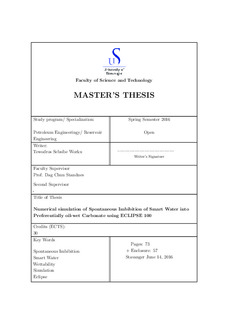Numerical simulation of Spontaneous Imbibition of Smart Water into Preferentially oil-wet Carbonate using ECLIPSE 100
Master thesis
Permanent lenke
http://hdl.handle.net/11250/2416807Utgivelsesdato
2016-06Metadata
Vis full innførselSamlinger
Sammendrag
Spontaneous imbibition (SI) is the main recovery mechanism in low matrix perme-
ability, naturally fractured reservoirs. However, for imbibition to occur, the reservoir
rock should be preferentially water-wet. Several studies have indicated that smart
water may increase the water-wetness of an oil-wet carbonate reservoirs. Published
experimental data suggest that sulfate ion in the injected
fluid can alter wetting
state of the carbonate from preferentially oil-wet to water-wet.
Numerical and analytical models have been developed to describe SI process in
carbonate reservoirs. The suggested models attempt to capture the complex inter-
actions among different phases and species during SI process. In this study, using
the already existing surfactant model of ECLIPSE 100 simulator, dynamic e ect of
adsorption of sulfate on wettability alteration in core scale is modelled. Wettability
change option of the surfactant model is employed to capture change in wettability
due to adsorption of sulfate ion. Using the procedure of weight factor, wettability of
the core shifts dynamically from oil-wet to water-wet conditions proportional to the
adsorbed amount of sulfate. Laboratory experiments have been matched with the
established procedure.
The result showed that the wettability change option under surfactant model in
ECLIPSE 100 is capable of modelling the change in wettability due to adsorption of
sulfate ion. The model is able to predict experimental data using the procedure of
weight factor. Moreover, a correlation between weight factor and Amott wettability
index is established. The basic model that could be used for further investigations
or upscaling to field scale is established.
Beskrivelse
Master's thesis in Petroleum technology
